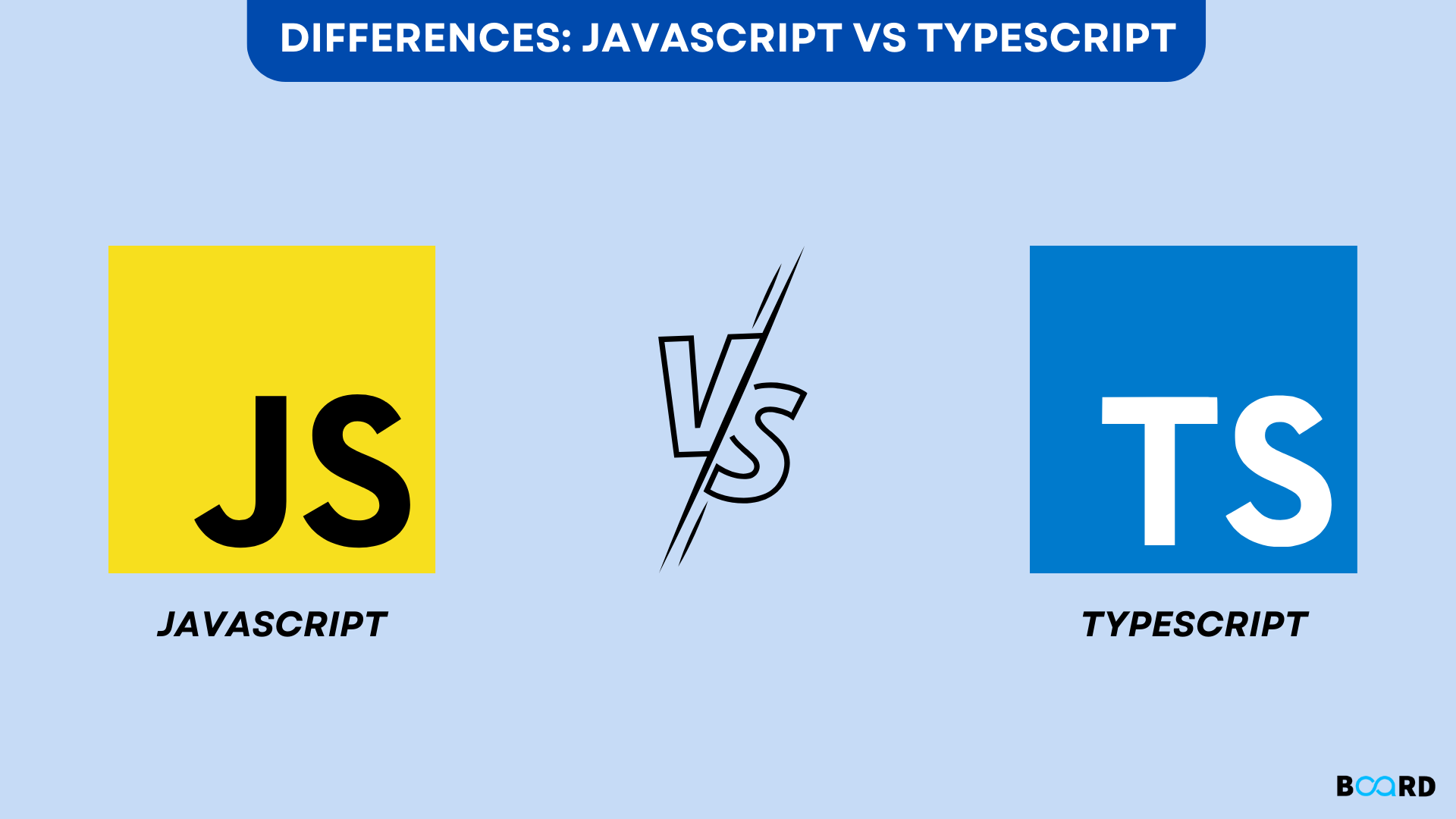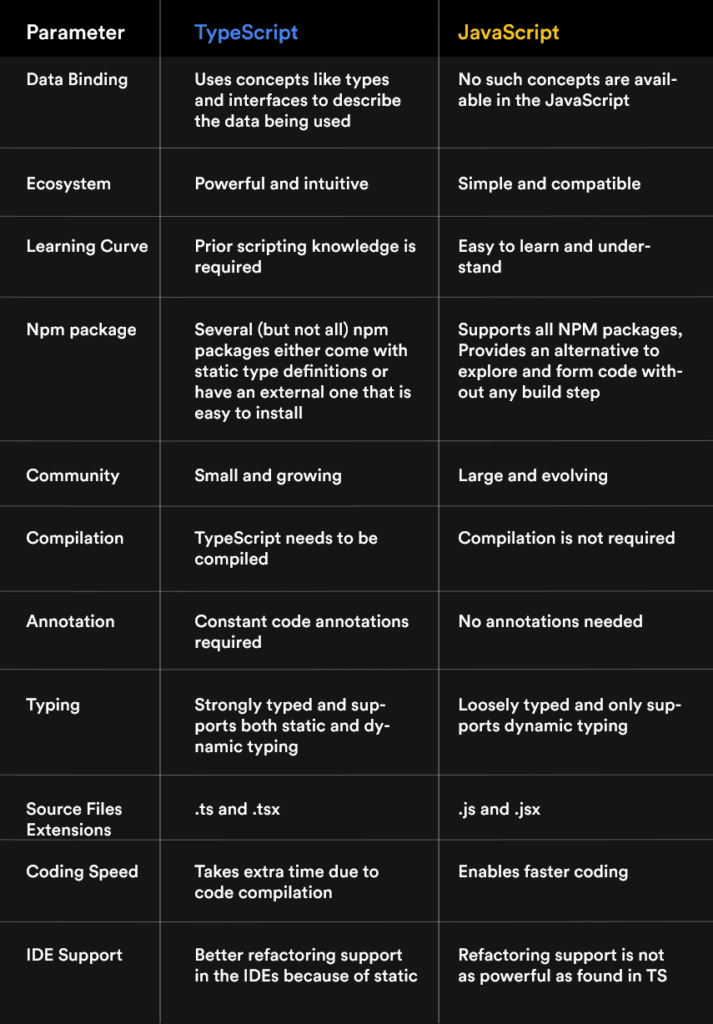Table of Content
- What is Typescript - Why we should use typescript
- Difference between JS & TS
- Setup TypeScript
- Type Anotation
- Type Aliases in Typescript
- Interface in Typescript
- Any in TypeScript
Anotate: Notation - Note - Comment - Footnote An additional piece of information printed at the bottom of a page.Explicitly: Clear - Obviously - Explained - UndeniablyImplicitly: Completely - Absolutely - Totally - Utterly- ``
- ``
TypeScript is a superset of JavaScript that adds static typing to the language, and it's commonly used in React development to catch errors early and improve code quality.
Different features of TS:
- Interface
- Enums
- Tuples
- Generic
- Classes, Abstract Class
Opt-In
| JavaScript | TypeScript |
|---|---|
| Weekly Typed Language | Strongly Typed Language |
| Seprate Programming Language | Is Programming language which is build on top of Javascript with new features |
| Mostly Errors on Runtime | Errors on Compile time |
| Mostly browsers support Js | TS require Transpiler to convert to JS, like Babel |
| Easy to Write & Difficult to maintane | Hard to write |
More Difference
To install and use TypeScript on Windows, follow these steps:
1. Install Node.js: 2. Open a Command Prompt or PowerShell: 3. Install TypeScript:
npm install -g typescriptDate: 25-11-23 current TSC version is 5.3.2
4. Verify the Installation:
tsc --versionhelp and more commonds:
tsc --help- Create File with
app.tsand transpile tsc app.ts this will generateapp.jsfile now run commondnode app.js
Hurray TS Code is running 🥳🎈
5. Other Method Create & Run TypeScript file
- Create Folder & Open VS Code
! npm init! npm install typescript6. Compile TypeScript to JavaScript
! npx tsc index.tsThis is becaus compiler can't understand directly typescript. his command invokes the TypeScript compiler (tsc) and generates a corresponding JavaScript file (index.js) based on your TypeScript code.
7. Run the JavaScript file:
! node index.jslet n:number = 10;
console.log(n)- Object
- Array
- String
- Boolean
- Function
Type annotations in TypeScript are used to explicitly specify
- the types of variables,
- function parameters, and
- function return values. By adding type annotations, you can provide additional information to the TypeScript compiler and enforce type safety in your code.
let age: number = 25;
let name: string = "John";
let isStudent: boolean = true;function greet(name: string) {
console.log(`Hello, ${name}!`);
}function add(a: number, b: number): number {
return a + b;
}let person: { name: string, age: number } = {
name: "John",
age: 25
};Type annotations help catch potential type errors during development, provide better tooling support, and enhance code documentation. However, TypeScript also supports type inference, so in many cases, you don't need to explicitly specify types as they can be automatically inferred based on the assigned values.
Type aliases create a new name for a type. Type aliases are sometimes similar to interfaces, but can name primitives, unions, tuples, and any other types
This can be helpful for making complex types more readable or for creating reusable types in your code.
Example without Type Alias
function greet(person: { name: string; age: number }) {
console.log(`Hello, ${person.name}! You are ${person.age} years old.`);
}
const user = { name: 'John', age: 25 };
greet(user);Example with Type Alias
type Person = { name: string; age: number };
function greet(person: Person) {
console.log(`Hello, ${person.name}! You are ${person.age} years old.`);
}
const user: Person = { name: 'John', age: 25 };
greet(user);Another Example With Type Alias
type User = {
name: string;
age: number;
isActive: boolean;
};
function createUser(user: User): User{
return user;
}
console.log(createUser({ name: "anonymous", age: 21, isActive: true }));You can say Interface is loose type of class.
interface Student {
readonly userId: number;
email: string;
studentId: number;
googleID?: number;
startTrail: () => string;
endTrail(): string;
fee(challanNo: number): number; // You can pass multiple parameters.
}
const Ali: Student = {
userId: 11,
email: "ali@enablehours.com",
studentId: 222,
startTrail: () => {
return "very soon";
},
endTrail: () => {
return "After Trails End";
},
fee: (no: 151515) => {
return 7000;
}
};Optional parameter help us to pass variables which are not necessary and may be you will use them in future.
interface Student {
email: string,
studentId: number,
! googleID?: number
}By defining readonly you can't reasign the value to Readonly variable.
interface Student {
! readonly userId: number
email: string,
studentId: number,
}interface Student {
readonly userId: number;
email: string;
studentId: number;
googleID?: number;
! startTrail: () => string;
! endTrail(): string;
! fee(challanNo: number): number;
}Some people say You can reopen interface🤣`
interface Student {
readonly userId: number;
email: string;
studentId: number;
googleID?: number;
startTrail: () => string;
endTrail(): string;
fee(challanNo: number): number;
}interface Student {
libraryCard: number
}You can do inheritence / Extend with Interface.
interface SeniorStudent extends Student {
role: "Admin" | "Head Boy" | "CR";
}Using any in TypeScript essentially disables type checking for the values it represents. While there might be scenarios where using any is necessary (e.g., when migrating a JavaScript codebase to TypeScript or when dealing with values of unknown types), it's generally recommended to avoid any whenever possible. The reason is that TypeScript's static type system provides several benefits, including catching potential errors at compile-time and improving code readability and maintainability.
Here's an example to illustrate why using any should be approached with caution:
- Using 'any'
function add(a: any, b: any): any {
return a + b;
}
const result: any = add(5, '10'); // No type errors, but unexpected behavior- Without 'any'
function addTyped(a: number, b: number): number {
return a + b;
}
// TypeScript will catch the error at compile-time
const resultTyped: number = addTyped(5, '10'); // Type error
